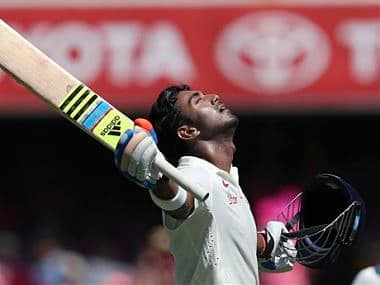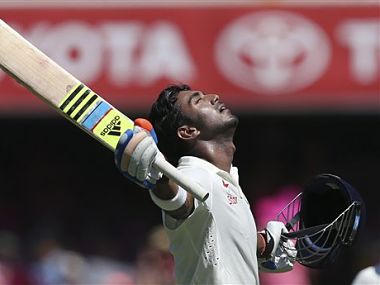India’s been rather spoiled by Virender Sehwag. Our idea of an opener is one who batters the new ball, rather than blunts it with a dead bat owes much to the right-hander’s manic success at the top of the order. An average of 49.34 (it dropped towards the end and once was as high as 55) coupled with a strike-rate of 82.23 meant that India will forever be looking for someone who bats in exactly the same vein. Sehwag is still around and just the other day slammed a century of 127 balls but his international days are far behind him. He last played a Test for India almost two years back – in Mar 2013. And while he was away, India thought it might have found a like-for-like replacement in Shikhar Dhawan. Dhawan started off where Sehwag left off – with a brilliant 187 against Australia at Mohali. But his success at the top of the order hasn’t been as enduring as Sehwag’s was. Just thirteen Test’s into his tenure, he finds himself replaced by a young 22-year-old from Karnataka, Lokesh Rahul. [caption id=“attachment_2036267” align=“alignleft” width=“380”]
 India’s Lokesh Rahul celebrates making his century. AP[/caption] And at the Sydney Cricket Ground, Rahul took us back to a pre-Sehwag era. He wasn’t about playing the big shots (though he showed later in his innings that he can do that as well), instead he was all about the dead bat. After 28 first-class matches, his average is 48.93 and his forte is just staying at the wicket for long periods. Rahul Dravid from the commentary box said: “He isn’t like Sehwag or even Dhawan. He is more like Vijay.” And for much of the first session he seemed very comfortable just keeping the Aussie bowlers out. In the first hour of play on Day three, he added 10 runs. In the second hour, he added just 9 more to reach his fifty – to show us exactly what Dravid was trying to convey. He had his brushes of luck – dropped on 46 by Steve Smith, who blamed the Spidercam wires for it. And a few other tough chances that didn’t go to hand but he took all that in his stride and made the most of it. “Batting up the order, gave me a little more time for myself. It was a very conscious effort to bat slow and get the early nerves off. I just kept telling myself to bat through the first session,” said Rahul at the end of the day. “More relieved than proud. It was a nightmare debut and it didn’t make my life easier. In the second Test, I dropped a sitter. I just kept telling myself that from here, the only way is up. After I batted last night, I knew the game was still bat and ball,” he added. With that also came the realisation that he needed to play his own game; the same game that got him a chance at the Test level. “It been very challenging and a lot of learning when you come into the senior team. They have showed a lot of faith in me by giving me this opportunity. Duncan and Shastri have been very supportive and talking to me a lot. Even after the last game, they just said ‘sometimes debuts do not go as planned. You have to spend a lot of time in the middle. Just pick yourself up and play.’ and that helped a lot.” As did the advice from fellow players. “I don’t know myself what was going on in mind. It was all going too fast. The other players told me – give yourself time between balls and remember to breathe,” said Rahul. That was something that kept him going and allowed him to focus on one ball at a time. After the fall of Rohit Sharma’s wicket – Rahul started playing more shots. It still wasn’t anything crazy but Kohli’s presence helped. Australia focused on the man in form and Rahul helped himself to a few runs, including a massive six off Lyon to get into the nineties. The century which came off 253 balls included 11 fours and 1 six and would have done Sunil Gavaskar proud. It was the kind of grinding effort that Gavaskar specialised in. At 22 years and 265 days, Rahul also became the youngest Indian to make a maiden Test 100 overseas since Ajay Ratra (20 years and 150 days) at St John’s in May 2002. But there are nervous ticks that Rahul needs to sort out. From time to time, he goes for a quick single that isn’t there or the pull/hook shot that would probably be best avoided. Technically there are still gaps to be filled but for most part, he seems to be mentally sorted. And for an opener, that is a big plus. “I have to leave the hook shot away for a while and be happy with the shots I have,” said Rahul after he was dismissed for 110 trying to play the hook shot. It was a ball that he could have and probably should have left well alone. He had been batting well but the century seemed to break his concentration. As a young kid, training in Bangalore, Dravid would often train with the under-15 team and that is where Rahul first got a look at him; to see how he trained and that influence is pretty evident. Rahul is not someone who will draw fans to the stadium, but as Shishir Hattangadi said on Twitter, “his ilk are the life line of Test batsmanship”.
India’s Lokesh Rahul celebrates making his century. AP[/caption] And at the Sydney Cricket Ground, Rahul took us back to a pre-Sehwag era. He wasn’t about playing the big shots (though he showed later in his innings that he can do that as well), instead he was all about the dead bat. After 28 first-class matches, his average is 48.93 and his forte is just staying at the wicket for long periods. Rahul Dravid from the commentary box said: “He isn’t like Sehwag or even Dhawan. He is more like Vijay.” And for much of the first session he seemed very comfortable just keeping the Aussie bowlers out. In the first hour of play on Day three, he added 10 runs. In the second hour, he added just 9 more to reach his fifty – to show us exactly what Dravid was trying to convey. He had his brushes of luck – dropped on 46 by Steve Smith, who blamed the Spidercam wires for it. And a few other tough chances that didn’t go to hand but he took all that in his stride and made the most of it. “Batting up the order, gave me a little more time for myself. It was a very conscious effort to bat slow and get the early nerves off. I just kept telling myself to bat through the first session,” said Rahul at the end of the day. “More relieved than proud. It was a nightmare debut and it didn’t make my life easier. In the second Test, I dropped a sitter. I just kept telling myself that from here, the only way is up. After I batted last night, I knew the game was still bat and ball,” he added. With that also came the realisation that he needed to play his own game; the same game that got him a chance at the Test level. “It been very challenging and a lot of learning when you come into the senior team. They have showed a lot of faith in me by giving me this opportunity. Duncan and Shastri have been very supportive and talking to me a lot. Even after the last game, they just said ‘sometimes debuts do not go as planned. You have to spend a lot of time in the middle. Just pick yourself up and play.’ and that helped a lot.” As did the advice from fellow players. “I don’t know myself what was going on in mind. It was all going too fast. The other players told me – give yourself time between balls and remember to breathe,” said Rahul. That was something that kept him going and allowed him to focus on one ball at a time. After the fall of Rohit Sharma’s wicket – Rahul started playing more shots. It still wasn’t anything crazy but Kohli’s presence helped. Australia focused on the man in form and Rahul helped himself to a few runs, including a massive six off Lyon to get into the nineties. The century which came off 253 balls included 11 fours and 1 six and would have done Sunil Gavaskar proud. It was the kind of grinding effort that Gavaskar specialised in. At 22 years and 265 days, Rahul also became the youngest Indian to make a maiden Test 100 overseas since Ajay Ratra (20 years and 150 days) at St John’s in May 2002. But there are nervous ticks that Rahul needs to sort out. From time to time, he goes for a quick single that isn’t there or the pull/hook shot that would probably be best avoided. Technically there are still gaps to be filled but for most part, he seems to be mentally sorted. And for an opener, that is a big plus. “I have to leave the hook shot away for a while and be happy with the shots I have,” said Rahul after he was dismissed for 110 trying to play the hook shot. It was a ball that he could have and probably should have left well alone. He had been batting well but the century seemed to break his concentration. As a young kid, training in Bangalore, Dravid would often train with the under-15 team and that is where Rahul first got a look at him; to see how he trained and that influence is pretty evident. Rahul is not someone who will draw fans to the stadium, but as Shishir Hattangadi said on Twitter, “his ilk are the life line of Test batsmanship”.
With KL Rahul as opener, India go back to the pre-Sehwag era
Ashish Magotra
• January 9, 2015, 08:20:31 IST
So even as a new Rahul rises – cut from the same cloth as the old one – one can’t help but wonder whether he can be as good as the old one?
Advertisement
)
End of Article